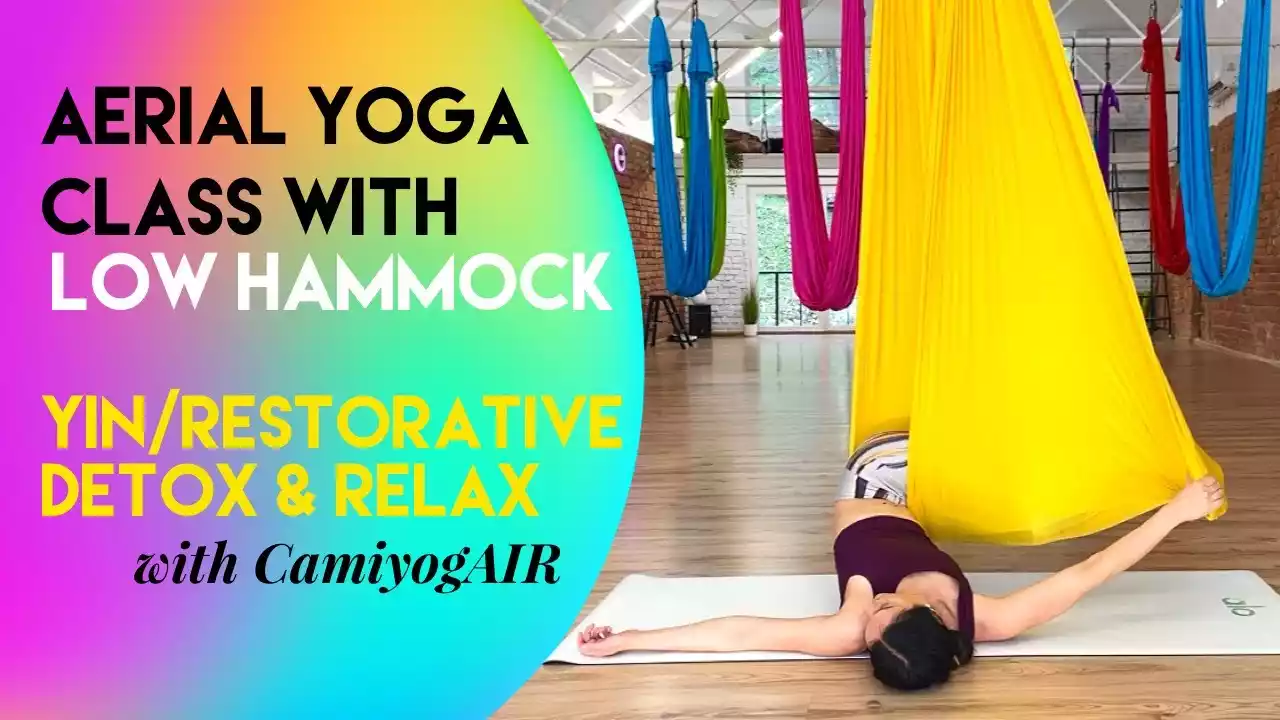Aerial Restorative Yoga is a unique blend of traditional yoga poses and the use of a hammock to support the body. This practice not only enhances flexibility and strength but also promotes deep relaxation and stress relief. Originating from the ancient traditions of yoga, aerial yoga has evolved to incorporate modern techniques, making it accessible and beneficial for practitioners of all levels. Let’s delve into the world of aerial restorative yoga and uncover its myriad benefits and practices.
Table of Contents
ToggleUnderstanding Aerial Restorative Yoga
What is Aerial Restorative Yoga?
Aerial Restorative Yoga combines the principles of traditional yoga with the use of a hammock or silk fabric suspended from the ceiling. This hammock acts as a support system, allowing practitioners to perform poses that might be challenging on the ground. The hammock helps in decompressing the spine, enhancing flexibility, and providing a sense of weightlessness.
Historically, yoga has been practiced for thousands of years, with its roots in ancient India. The integration of aerial elements into yoga is a relatively modern innovation, gaining popularity in the early 21st century. This fusion has opened up new possibilities for deepening the practice and achieving greater physical and mental benefits.
Benefits of Aerial Restorative Yoga
Aerial Restorative Yoga offers numerous benefits, both physical and mental. Here are some key advantages:
• Enhanced Flexibility: The hammock allows for deeper stretches and greater range of motion.
• Spinal Decompression: Hanging upside down helps in relieving pressure on the spine and alleviating back pain.
• Improved Strength: Supporting the body weight in various poses builds core and upper body strength.
• Stress Relief: The gentle, supported poses promote relaxation and reduce stress levels.
• Better Balance: Practicing in the hammock improves overall balance and coordination.
Getting Started with Aerial Restorative Yoga
Embarking on your aerial restorative yoga journey requires some preparation and understanding of the basics. Here’s how to get started:
Essential Equipment for Aerial Restorative Yoga
Choosing the Right Hammock
Selecting the appropriate hammock is crucial for a safe and effective practice. Here are some tips:
• Material: Look for high-quality, durable silk or nylon fabric.
• Weight Capacity: Ensure the hammock can support your body weight.
• Installation: Proper installation is vital. Use secure ceiling mounts and follow manufacturer guidelines.
Safety Tips and Precautions
Safety should always be a priority. Here are some precautions to keep in mind:
• Proper Installation: Ensure the hammock is securely installed and can support your weight.
• Warm-Up: Always start with a gentle warm-up to prepare your body.
• Listen to Your Body: Avoid pushing yourself too hard and stop if you feel any discomfort.
• Use a Spotter: Having someone to assist you can prevent accidents, especially when trying new poses.
Key Poses in Aerial Restorative Yoga

Beginner Poses
Starting with beginner poses helps in building confidence and understanding the basics of aerial yoga. Here are a few to try:
• Supported Child’s Pose: Sit back into the hammock, allowing it to support your hips and lower back. This pose gently stretches the spine and relaxes the mind.
• Floating Savasana: Lie back in the hammock, letting your body be fully supported. This pose promotes deep relaxation and stress relief.
Advanced Poses
As you gain confidence and strength, you can progress to more advanced poses:
• Inverted Pigeon: This pose involves hanging upside down with one leg crossed over the other, stretching the hips and lower back.
• Aerial Split: A challenging pose that requires flexibility and strength, where you perform a split while being supported by the hammock.
Integrating Aerial Restorative Yoga into Your Routine
Creating a Home Practice
Practicing aerial restorative yoga at home can be convenient and rewarding. Here’s how to set up your home practice:
• Designate a Safe Space: Ensure you have enough room to move freely and that the ceiling can support the hammock.
• Follow Online Tutorials: Utilize resources like this YouTube tutorial to guide your practice.
• Maintain Consistency: Regular practice is key to reaping the benefits of aerial yoga.
Finding Classes and Instructors
If you prefer guided practice, finding a qualified instructor or class can be beneficial:
• Certified Instructors: Look for instructors with certification in aerial yoga to ensure safe and effective teaching.
• Local Studios: Many yoga studios offer aerial yoga classes. Check their schedules and join a class that fits your level.
• Online Options: Platforms like Gravotonics offer online classes and resources for aerial yoga enthusiasts.
Common Challenges and How to Overcome Them

Physical Challenges
Aerial restorative yoga can present physical challenges, especially for beginners. Here’s how to tackle them:
• Building Strength: Start with basic poses and gradually increase the difficulty as your strength improves.
• Flexibility Issues: Incorporate regular stretching into your routine to enhance flexibility over time.
• Dealing with Discomfort: Use additional props like cushions or blankets to make poses more comfortable.
Mental and Emotional Challenges
Mental and emotional challenges can also arise during your practice. Here’s how to address them:
• Overcoming Fear: Fear of falling or trying new poses is common. Start with poses close to the ground and gradually build confidence.
• Staying Present: Focus on your breath and the sensations in your body to stay present and mindful during practice.
• Managing Stress: Use the relaxation techniques learned in aerial yoga to manage stress in your daily life.
Relevant Data Table For The Aerial Restorative Yoga:
| Aspect | Details |
|---|---|
| Definition | Aerial Restorative Yoga combines traditional yoga poses with a hammock. |
| Key Benefits | Improved flexibility, reduced stress, enhanced relaxation. |
| Essential Equipment | Yoga hammock, supportive props, comfortable clothing. |
| Safety Precautions | Ensure proper installation, use spotters, avoid overexertion. |
| Beginner Poses | Supported Child’s Pose, Floating Savasana. |
| Advanced Poses | Inverted Pigeon, Aerial Split. |
| Home Practice Tips | Designate a safe space, follow online tutorials, maintain consistency. |
| Finding Classes | Look for certified instructors, join local studios, explore online options. |
FAQs:
What should I wear for aerial restorative yoga?
Choosing the right attire for aerial restorative yoga is essential for comfort and safety. Here are some tips:
• Fitted Clothing: Wear form-fitting clothes to avoid any fabric getting caught in the hammock. Loose clothing can be a hazard.
• Breathable Fabric: Opt for materials like cotton or moisture-wicking fabric to keep you comfortable during the practice.
• Avoid Zippers and Buttons: These can snag on the hammock and cause discomfort or damage to the fabric.
• Barefoot or Grip Socks: Practicing barefoot allows for better grip and control. If you prefer wearing socks, choose ones with grips to prevent slipping.
How often should I practice aerial restorative yoga?
The frequency of your practice depends on your goals and physical condition. Here are some guidelines:
• Beginners: Start with 2-3 sessions per week to allow your body to adapt to the new practice.
• Intermediate Practitioners: Increase to 4-5 sessions per week as your strength and flexibility improve.
• Advanced Practitioners: Daily practice can be beneficial, but ensure you listen to your body and avoid overexertion.
Can beginners try aerial restorative yoga?
Absolutely! Aerial restorative yoga is suitable for beginners. Here’s how to get started:
• Start with Basic Poses: Begin with simple poses that allow you to get comfortable with the hammock.
• Take a Class: Joining a beginner’s class can provide guidance and support from a qualified instructor.
• Use Props: Additional props like blocks or cushions can make poses more accessible and comfortable.
Are there any contraindications for aerial restorative yoga?
While aerial restorative yoga is generally safe, certain conditions may require caution or avoidance. Here are some considerations:
• Pregnancy: Consult with your healthcare provider before starting aerial yoga if you are pregnant.
• Recent Surgery or Injury: Avoid aerial yoga if you have had recent surgery or are recovering from an injury.
• High Blood Pressure: Inversions can increase blood pressure, so consult with a healthcare provider if you have hypertension.
• Glaucoma: Inversions can increase pressure in the eyes, so avoid these poses if you have glaucoma.
How do I know if my hammock is installed correctly?
Proper installation of the hammock is crucial for safety. Here’s how to ensure it’s done correctly:
• Follow Manufacturer Guidelines: Adhere to the instructions provided by the hammock manufacturer.
• Secure Ceiling Mounts: Use strong, secure mounts designed for aerial yoga hammocks.
• Check Weight Capacity: Ensure the hammock and mounts can support your body weight.
• Test Stability: Before using the hammock, test its stability by gently pulling and sitting in it.
Conclusion:
Aerial Restorative Yoga offers a unique blend of relaxation and physical benefits, making it an excellent addition to any wellness routine. By understanding the basics, investing in the right equipment, and practicing safely, you can enjoy the numerous advantages this practice has to offer. Whether you’re a beginner or an advanced practitioner, aerial restorative yoga can help you achieve a deeper sense of peace and well-being.
Posts References:
Aerial Yoga Low Hammock Class | 6 Restorative Poses to Relax the …
What Is Restorative Aerial Yoga? – Gravotonics







